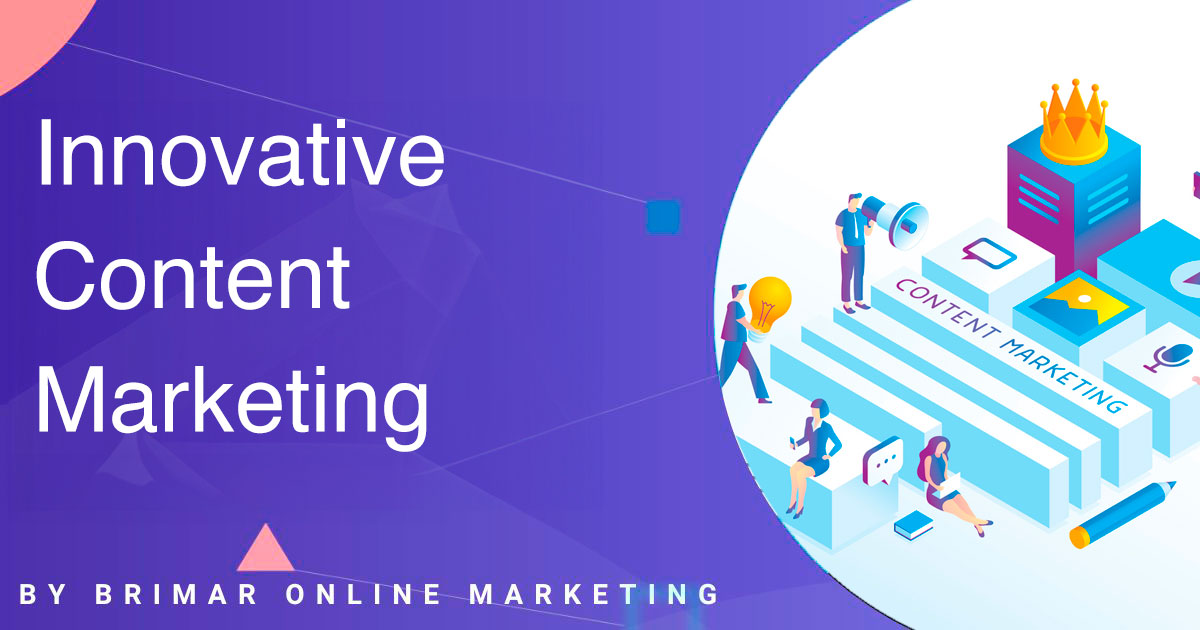
Content marketing is a type of marketing that involves writing and sharing online content like blogs, newsletters, podcasts, e-books / white papers, and emails.
The purpose is to attract as many audiences as possible to your product, service, or brand, and give quality content to provide solutions to people’s problems.
Unlike other marketing techniques, content marketing is implicit – meaning that it doesn’t necessarily scream the CTA (aka call-to-action) for customers to buy a product.
But, it gains it through providing useful insights for a topic that people tend to interact with more often.
In such a way, customers get quality thoughts and entertainment, while businesses get a chance to attract customers to their products or services.
In this post, we will discuss content marketing techniques other than blogging and explore their possibilities and technicalities. Let us start by telling you why you should go beyond blogging.
Need a Sales Funnel that Converts?
Struggling to turn clicks into customers?
A high-converting sales funnel could be the missing link. We’ll help you build a simple, straightforward, and effective funnel that guides your visitors step-by-step, so they take action, not just browse.
Why Should You Adopt Marketing Methods Other Than Blogging?

In today’s era, you should also explore parallel ways of content marketing to elevate your business to the next level.
We are not saying that you stop blogging altogether (as it has its loyal audience) but also invest resources in other marketing techniques.
This is because, during the past few decades, the content people want to consume has changed a lot.
Many don’t have a lot of time to read, so they listen to podcasts, while some professionals tend to check more emails than blogs. And some simply prefer white paper literature more than any other source of information.
Thus, it is necessary to tap into the diversified fields of content to increase your chances of spreading the word – to maximize your sources of marketing and, hopefully, more sales.
What Are Some Content Marketing Techniques Other Than Blogging?
There are many other content marketing techniques that you can use other than blogging. We will discuss them one by one in detail.
1. Emailing

Emailing is the digital form of mail.
You can write bi-weekly, weekly, or monthly emails to your audiences addressing them directly without any involvement of a third party.
This will allow you a chance to connect with your audience and let you share your personal/emotional journey with them. Besides this, you can fully express your thoughts and opinions as well.
Our pro tip is to pour your heart out. This way, people will surely connect with your words and comply with the implied CTA you mention there.
2. Creating and Sending Newsletters.

Newsletters are news or updates about current events or the ones that might occur in the future.
They are either sent or distributed through physical means (printed form), or digital means like emails. Thus, they are under the umbrella of email marketing.
Newsletters are a one-off communication in which you deliver your customers an update message without requiring a reply from them.
Newsletters are another strong method of marketing content. You can use them to update your audiences about your products or services or to tell them about an organizational change (if any) that you are undergoing with your business.
Unlike promotional emails, newsletters are written in a highly formal tone delivering the message directly with no heartfelt emotions or personal anecdotes. Thus, you might need to rework your tone in existing content pieces for your newsletters.
You can do so by rewording your words to sound more professional. This must be done as your email is no longer a poetic piece of work, but a professional document that needs delivering as such.
However, if you are finding it difficult to rephrase or redirect your work manually, you can always get help from an online rewording tool. Most tools are now based on AI engines, which can predict a set of synonyms and change words according to a professional setting.
This also makes your tone accurate for content delivery without any miscommunication or misinterpretation of the message.
Let us show you what we mean:

Thus, the emphasis of newsletters is on delivering the message with a formal tone without carrying any emotional biases.
3. Publishing E-Books And White Papers

E-books, or physical books, are considered white papers as a majority of them come from certified publications.
White papers contain detailed documentation or discussion about a research topic.
They dissect minute details of the well-known problem and try to devise solutions for it.
As e-books and white papers are pre-internet, they’re even more ancient and credible sources of information than blogs. Many people still prefer reading them, so use this audience to achieve your business goals.
Look to utilize books as a source of content marketing by applying these few tips:
- Paid Advertisement: Hard copies of the published books have advertised content on their book covers. Use this space to advertise your content and gain more potential customers. The same applies to e-books, where you can show advertisements to pull traffic to your online platform.
- Provide add-ons: Provide some sort of add-on value with your books. A case in point would be the “Practice” book by Cambridge. They provide an attached CD (compact disk) with a hard copy of their book. Providing add-ons ensures that you re-link your audience from the hard material back to your digital ecosystem. This way, you can keep your audiences engaged with your material, hence, improving your business.
4. Podcasts

Last but not least, look to market your content through podcasts.
Podcasts are detailed discussions on a certain topic or range of topics. They generally involve multiple people debating to form a consensus on a topic or reach an ‘agree-to-disagree’ stance.
They are usually long videos but are also available as audio, or ‘listenable’ on a lot of platforms.
The reason for podcast’s recent popularity is their convenience. They provide a hands-free experience where listeners can tune in while doing their job or performing any other leisure activity.
Thus, you should either invest in making a podcast show with famous guests, or partner up with show-casters to give you shout-outs or mentions about your brand, services, or products in their show.
Expanding Your Content Marketing Strategy Beyond the Basics
When enhancing your content marketing strategy, it’s essential to think beyond standard formats and experiment with diverse approaches that resonate with your target audience.
Whether you’re a seasoned content creator or just beginning your journey in digital marketing, there are innovative ways to deliver high-quality content that draws attention, builds trust, and grows your brand awareness.
1. Harnessing the Power of Video Content
Video content has emerged as one of the most effective ways to capture your audience’s attention.
Unlike static blog posts, video allows you to engage viewers on a deeper level, whether through tutorials, explainer videos, live Q&As, or product demos.
Social media platforms, particularly those favoring short-form video like TikTok and Instagram Reels, are a great place to share video content.
You could also consider live videos, which offer an interactive content experience where viewers can engage in real-time.
If your brand focuses on creating educational content, video is an excellent format for delivering valuable information.
Tutorials and how-to guides, for instance, demonstrate your brand’s expertise and offer practical insights that can attract new customers.
Video content also improves user experience by making information digestible and visually appealing, a critical factor for brands looking to rank well on search engines.
According to the Content Marketing Institute, video content consistently ranks as a powerful tool in an effective content marketing strategy.
2. Utilizing Case Studies and Original Research
For businesses aiming to establish credibility and position themselves as industry leaders, case studies and original research are among the best ways to showcase expertise.
You provide valuable insights that resonate with your target market by sharing in-depth analyses of previous marketing campaigns, customer success stories, or research findings.
Content marketers find that case studies are a great example of high-quality content that supports consumer decision-making and demonstrates how your products or services can address specific challenges.
Original research, in particular, sets your brand apart as a thought leader.
You are publishing findings based on consumer behavior, industry trends, or unique insights to position your brand as a source of valuable content that others will reference.
This type of content strengthens your online presence and helps improve search engine optimization, as it tends to attract backlinks and social shares.
3. Incorporating Interactive Content for Engagement
Interactive content, such as quizzes, surveys, and polls, offers a fun and engaging experience that can enhance customer satisfaction.
Unlike traditional content forms, interactive content encourages users to participate actively, which can deepen engagement.
It’s a good idea to incorporate elements that allow your audience to personalize their experience, such as assessment tools, calculators, or even virtual reality experiences.
This is especially effective on social media channels, where users are more likely to engage with dynamic and responsive content.
Interactive content also provides valuable insights into your audience’s preferences and interests, enabling you to tailor future content marketing strategies more effectively.
Additionally, it’s a great way to increase time spent on your site, signaling to search engines that your content is relevant and valuable.
4. Guest Posts and Collaborations with Industry Experts
Guest posts on reputable sites or blogs in your niche are another excellent way to extend your brand reach and build authority.
Collaborating with industry experts as guest contributors diversifies your content and introduces your brand to new audiences.
Guest posts are particularly beneficial for smaller businesses looking to establish themselves in competitive markets, as they offer credibility and often include backlinks, which can improve your search results.
Additionally, featuring industry experts or influencers on your blog or podcast can be a great way to build authority.
Leveraging influencer marketing and inviting thought leaders to contribute to your blog or participate in social media posts can enhance your brand’s image and draw the attention of followers who value expertise and insider knowledge.
This collaborative approach fosters goodwill and provides an authentic endorsement that can be valuable for business owners aiming to boost their digital marketing efforts.
5. Leveraging User-Generated Content and Customer Testimonials
User-generated content (UGC) is a valuable and cost-effective way to enrich your content marketing plan.
This includes testimonials, reviews, photos, and videos your customers share, showcasing their experiences with your product or service.
UGC helps humanize your brand, providing social proof that can be influential in attracting new customers.
A successful content marketing strategy often encourages users to share their experiences on social media platforms, creating a community of brand advocates who enhance customer loyalty.
Customer testimonials, especially video or image-based social media content, can also strengthen your marketing efforts.
Sharing positive reviews or customer experiences on your website, social media channels, or email newsletters demonstrates customer satisfaction and reinforces trust in your brand.
Consider using a hashtag or creating a dedicated page for customer stories as an easy way to collect and showcase UGC.
6. Exploring Emerging Technologies Like Artificial Intelligence and Virtual Reality
Integrating artificial intelligence (AI) in content marketing opens up exciting possibilities.
AI tools can help with content ideas, personalized recommendations, and even automated chatbots to improve customer service.
For instance, using AI to analyze key performance indicators (KPIs) can reveal what types of content are performing well, which is crucial for content marketers aiming to optimize their strategies.
Similarly, virtual reality (VR) offers a cutting-edge approach to content creation.
Through VR, businesses can provide immersive experiences, such as virtual product demonstrations, which allow potential customers to explore products before purchasing.
While still in the early stages for many brands, VR presents a unique opportunity to captivate audiences and stand out in a crowded digital landscape.
7. Implementing a Content Strategy for Social Media Marketing
A robust social media marketing strategy is essential for brands today.
Social media channels like Facebook, Instagram, LinkedIn, and X offer an unparalleled platform for sharing diverse content types, from quick tips and news updates to live videos and interactive polls.
Aligning your content strategy with the latest trends on these platforms helps maximize reach and foster brand awareness.
Social media is also great for testing new ideas and experimenting with different content formats.
For example, Instagram Stories and LinkedIn articles offer different ways to engage audiences with short-form content, while X is an excellent platform for timely industry news and updates.
The goal is to create relevant content that resonates with your audience at the right time, building a community of engaged followers who value your insights.
8. Developing a Comprehensive Email Marketing Campaign
Email newsletters remain one of the most effective content marketing tools.
Through a well-executed email marketing campaign, you can deliver valuable information directly to your audience’s inbox, whether it’s product updates, educational content, or original content that adds value.
Segmenting your email list based on user preferences and behavior ensures subscribers receive content tailored to their interests, enhancing the user experience and increasing engagement.
One best practice for email marketing is to personalize the content as much as possible.
Personalized emails see higher open and click-through rates, making them an easy way to drive conversions.
Consider using A/B testing to determine what types of content resonate most with your audience and continuously optimize your campaigns to improve results.
9. Crafting Content for a Mobile-First Audience
Optimizing your mobile content is crucial as mobile device usage continues to rise.
Mobile-friendly content ensures a seamless user experience, which can lead to improved engagement and better search engine rankings.
Whether through a mobile app, responsive website design, or mobile-optimized emails, content that is easy to consume on a smartphone or tablet is now a must-have in any content marketing plan.
Brands should also consider creating shorter, more digestible content that caters to mobile users.
For instance, quick tips, concise blog posts, and short video clips are ideal for audiences on the go, providing valuable information in a format suited to mobile viewing.
10. Keeping Content Marketing Efforts Aligned with Industry Trends
Finally, content marketers must stay updated on the latest industry trends and consumer behavior.
Following reputable sources like the Content Marketing Institute, the New York Times, or other industry leaders can offer fresh content ideas and inspiration.
Regularly reviewing these sources can also help you identify shifts in your target market’s preferences, allowing you to adjust your content strategy accordingly.
By focusing on trends such as voice search, AI-driven personalization, and mobile optimization, you ensure that your content marketing efforts remain relevant and practical.
Monitoring changes in consumer preferences and exploring innovative marketing approaches helps keep your brand ahead of the curve and prepared to meet the evolving needs of your audience.
Conclusion
Developing a successful content marketing strategy goes beyond traditional methods.
By incorporating video content, interactive experiences, original research, social media strategies, user-generated content, and cutting-edge technology, businesses can create high-quality content that resonates deeply with their target audience.
This approach builds brand loyalty and positions your brand as a trusted industry leader, enhancing your online presence and increasing customer loyalty.
Remember, the key to effective content marketing lies in delivering valuable content that aligns with your audience’s needs at the right time, turning potential customers into loyal advocates.
Our Digital Marketing Services Have Helped Our Clients Increase Their Revenue!
“I highly recommend Brimar if your looking to grow your online business. You will be satisfied with the high level of expertise and high quality of services. It has helped my business grow by leaps and bounds.”
CEO

